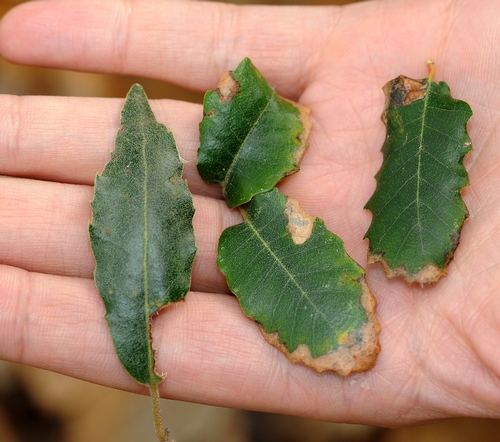When you visit the Peter J. Shields Oak Grove in the UC Davis Arboretum, you'll see one of the most diverse mature oak collections in the United States. More than 80 kinds of oaks, including scientifically documented trees native to the United States,Central America, Europe and Asia are planted there.
The dominant native oak is the Valley oak, Quercus lobata Née.
What Ian Pearse, a UC Davis researcher in the Department of Entomology, wanted to know was this: "Why do insects interact with some non-native plant species but not others?"
In a study encompassing three summers and 57 species of introduced (non-native) oaks in the grove, he found that many insects that target California’s native oak trees will also feed on non-native oaks planted near them, but with one distinct difference: the insects tend to do more damage to the non-native oaks that are closely related to the natives, than they do to the distant relatives.
“This is a confirmation of the ideas dating back to Darwin,” said Pearse, a doctoral candidate in the Department of Entomology who studies with major professor and noted insect ecologist Rick Karban.
Pearse and co-author Andrew Hipp of the Illinois-based Morton Arboretum and Field Museum of Natural History, Chicago, published their results in a recent edition of the journal, Proceedings of the National Academy of Sciences (PNAS).
“The insects were mostly small moths, fairly inconspicuous,” Pearse said. “They don’t cause a lot of damage. This was more of a theoretical study, of how insects on native oaks also tend to interact with non-native oaks that are similar.”
“Ian's study is important for several reasons,” said Karban. “Our collective intuition about what makes some introduced plants, including crop species, more susceptible to herbivores than others is poorly developed. By using a large number of oak species planted in a common environment, and accounting for the relatedness of the species, Ian can answer that question with a great deal of elegance and power. His finding that relatedness of the various oaks to the native species explains a lot of the picture and provides considerable insight.”
The journal cover features an image of the mural “Oak Family Tree,” from the UC Davis Arboretum oak collection. The mural, created through the UC Davis Art/Science Fusion Program, taught by entomology professor and artist Diane Ullman and artist Donna Billick, depicts the evolutionary relationships of 29 oak species and the animals associated with each species.
“The project was a collaboration with the arboretum,” Ullman said, noting that Emily Griswold, a national leader in oak conservation and the Arboretum’s assistant director of horticulture, “provided the leadership and knowledge base from the arboretum.”
The PNAS article is drawing widespread interest from ecologists, taxonomists and oak enthusiasts. Pearse is the first person to create a phylogeny of the oaks in Shields Oak Grove. Internationally recognized oak expert John Tucker (1916-2008), former UC Davis botany professor and a former director of the Arboretum, helped plant the trees nearly half a century ago.
And now we know more about the insects that interact with those oaks.
Attached Images:

Ian Pearse

Insect Damage